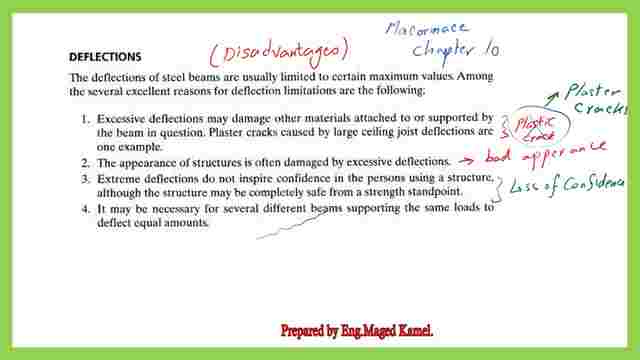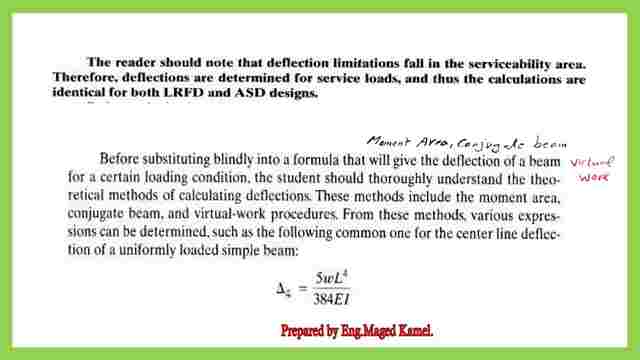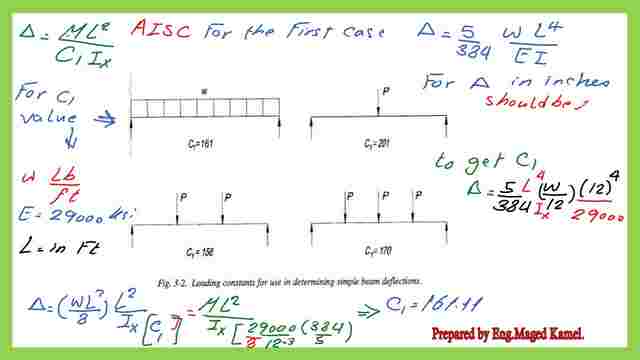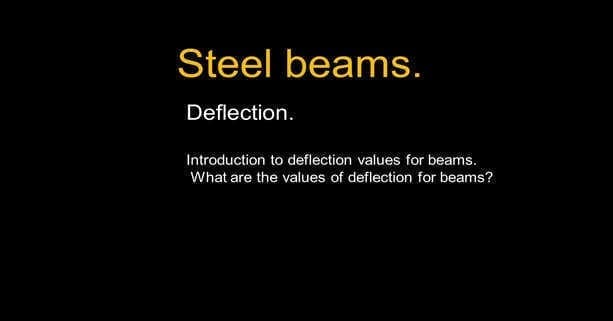Deflection of steel beams part 1.
This is the content of the lecture what are the deflection parameters?


What are the disadvantages of the deflection of steel beams?
This is a quote from Prof.Mccormac’s book chapter 10. the deflection is usually limited to The deflection to be controlled by a maximum value, since it may damage other materials and create no plastic cracks.
The deflection may damage other materials attached to or supported by the beam in question, the second point, appearance that structures are often damaged by excessive deflections, which give a bad appearance.
The third point is loss of confidence due to the appearance of deflection for a building. The last point it may be necessary for several different beams supporting the same loads to deflect equal amounts for appearance purposes to be the same amount of deflection.


What are the parameters of the deflection of steel beams?
The live load deflections are approximately L/360 of the span length. However the reader should note that the limitation of the deflection of steel beams falls in the serviceability area. Therefore, deflections are determined for the service loads, so we cannot use the Ultimate loads, for example, the 1.2D+1.60L combination of loads to estimate the deflection.
What are the tools that enable us to determine deflection? We use the moment area method and we convert the area of moments into loads from which we estimate the shear forces, which gives us the value of the slope.
While from the bending produced from Moment loads, we can evaluate the deflection values and also the use of the conjugate beam method, which converts the end cantilever portion into fixed support and converts the hinged end into hinged supports.


The third method is virtual work. The deflection value = 5WL^4/384*EI for a simply supported beam under uniform load.


IBC provision for deflection.
The IBC which is the building international building code, in which the beam deflection values are categorized into three categories, was Quoted from Prof. Fredrick Roland’s book Steel Design for Civil P.E.
The first item is for the roof members Live load L& snow load S or wind load W, or wind load W, and the third category is the dead load plus live load D+L, for each category, roof members, if supporting plaster ceilings the deflection value
permitted for live load L=L/360, while for snow Load s, or wind load W, the deflection =L/360, for D+L the deflection is L/360.
While fo Roof members, if supporting non-plaster ceilings the deflection values increased and became for live load L=L/240, while for snow Load s, or wind load W=L/240, for D+L the deflection is L/180.
For floor members, we do not have snow loads.
The allowable deflection is permissible under Live Loads L =span/360, while for D+L loads the deflection will be considered as ( span/240).


In the new section in the AISC, a new coefficient was given as a C1 factor to account for the errors due to the different factors, the deflection is delta =M*L^2/(C1*Ix), so instead of using a deflection value of (5/384)w*L4/EI, we consider instead, M as (W*L^2/8), L as span length in inches, w in kips/inch and E as 29000ksi, we can get the c1 value.
The next image explains how we get the value of c1 for the deflection of a simply supported beam under a uniform loading.


This is the pdf file used in the illustration of this post.
As an external resource for the deflection. Chapter 8 – Bending Members
This is a link for the next post, solved problem 5-1-part 1-2.

